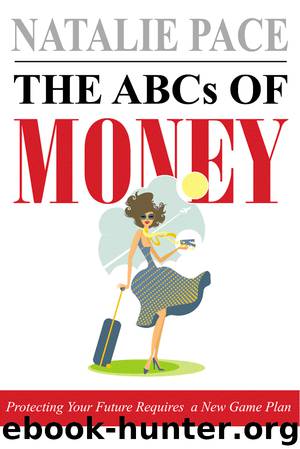The ABCs of Money by Pace Natalie

Author:Pace, Natalie [Pace, Natalie]
Language: eng
Format: epub, mobi
Tags: BUSINESS &, ECONOMICS/Personal Finance/Investing
Published: 2012-12-03T23:00:00+00:00
Here are More Details to Help You Set Up Your Nest Egg
Add up the total value of all of your “nest eggs” – i.e. your 401Ks (old & new), your IRA, your annuity and your savings. This total is what you want to consider as your nest egg pie chart. (Don’t include real estate, your car, jewelry, or any other valuable collectible. Hard assets are part of your total asset value, but are non-liquid assets, whereas your nest egg deals with liquid, paper assets.)
Keep a percentage equal to your age “safe.” As an example, if you have $100,000 in your 401K, IRA and savings account, and you are 50, you would be keeping $50,000 “safe.” There are many assets that are safer than stock. Most of the time, you can overweight safe easily, using bonds, Treasury Bills, Certificates of Deposit and FDIC insured savings accounts. These days, you have to be a lot more careful about bonds, even those that are highly rated. As I’ve said a lot in this book, safe, cash-positive, yielding hard assets – like income property – will do better in the years to come than paper assets. Read the fine print on all of your “safe” paper assets to be sure that they are as safe as you think. Is your high-yield certificate of deposit FDIC-insured? What kind of safety net does your annuity offer, if the insurance company gets into trouble, like AIG did? Is there any circumstance where the payback on your annuity, bond or fund might be less than you are counting on? Are you more at risk than you know? Ask the hard questions now, rather than being a dollar short at the end of the day, when you need it most. It is very important that your “safe” money is not at risk of loss of principal.
Protect an additional 10-20% percent during recessions and times of grave uncertainty. This is what I call overweighting safe.
Take the remaining “pie” and divide that into ten slices. One fund represents one “slice.” Ten funds are easy to manage and easy to do the math on. Dozens of funds are confusing, hard to add up and thus, it is difficult to see your return on investment.
Diversify six of the slices by size and style. Small cap growth, small cap value, mid cap growth, mid cap value, large cap growth and large cap value. Why? Because different parts of the market perform differently. NASDAQ doubled off of its low in March 2009, whereas the Dow Jones Industrial Average recovered at half the speed. Small cap stocks returned 7.05% annually between 2002 and 2011, while the large companies made only 2.9% annually over the same period. In general, small caps add performance and large caps add stability. Value means you are buying the company stock on sale and growth means the company is enjoying a robust increase in sales.
Four of the slices will be Hot Industries. Hot industries really outperform their peers.
Download
This site does not store any files on its server. We only index and link to content provided by other sites. Please contact the content providers to delete copyright contents if any and email us, we'll remove relevant links or contents immediately.
| Analysis & Strategy | Bonds |
| Commodities | Derivatives |
| Futures | Introduction |
| Mutual Funds | Online Trading |
| Options | Portfolio Management |
| Real Estate | Stocks |
Pioneering Portfolio Management by David F. Swensen(5733)
Rich Dad Poor Dad by Robert T. Kiyosaki(5385)
How To Win Friends and Influence People by Dale Carnegie(3943)
The Money Culture by Michael Lewis(3422)
The Dhandho Investor by Mohnish Pabrai(3258)
The Wisdom of Finance by Mihir Desai(3187)
Liar's Poker by Michael Lewis(2934)
The Intelligent Investor by Benjamin Graham Jason Zweig(2673)
The ONE Thing by Gary Keller(2621)
Mastering Bitcoin: Programming the Open Blockchain by Andreas M. Antonopoulos(2613)
How to Day Trade for a Living: Tools, Tactics, Money Management, Discipline and Trading Psychology by Andrew Aziz(2552)
Investing For Dummies by Eric Tyson(2551)
Fooled by Randomness: The Hidden Role of Chance in Life and in the Markets by Nassim Nicholas Taleb(2539)
How to Win Friends and Influence People by Dale Carnegie(2534)
Rich Dad Poor Dad: What The Rich Teach Their Kids About Money - That The Poor And Middle Class Do Not! by Robert T. Kiyosaki(2503)
Zero Hour by Harry S. Dent Jr. & Andrew Pancholi(2308)
Market Wizards by Jack D. Schwager(2251)
How to Pay Zero Taxes, 2018 by Jeff A. Schnepper(2207)
Rich Dad's Guide to Investing by Robert T. Kiyosaki(2186)
